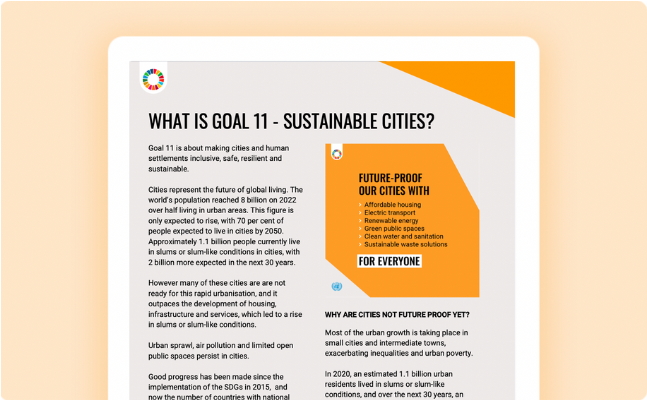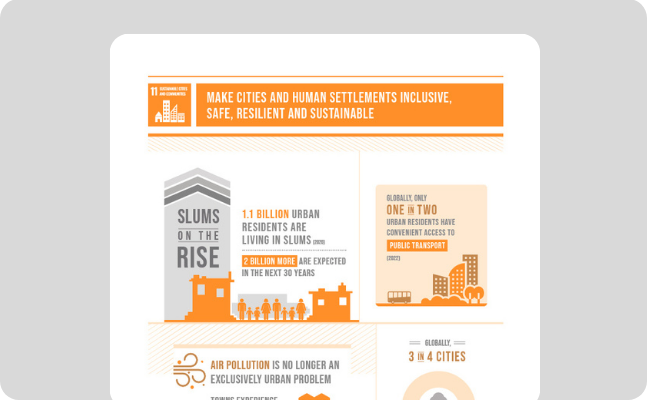Goal 11 is about making cities and human settlements inclusive, safe, resilient and sustainable.
Cities represent the future of global living. The world’s population reached 8 billion on 2022 over half living in urban areas. This figure is only expected to rise, with 70 per cent of people expected to live in cities by 2050. Approximately 1.1 billion people currently live in slums or slum-like conditions in cities, with 2 billion more expected in the next 30 years.
However many of these cities are not ready for this rapid urbanisation, and it outpaces the development of housing, infrastructure and services, which led to a rise in slums or slum-like conditions.
Urban sprawl, air pollution and limited open public spaces persist in cities.
Good progress has been made since the implementation of the SDGs in 2015, and now the number of countries with national and local disaster risk reduction strategies has doubled. But issues still remain and in 2022, only half of the urban population had convenient access to public transport.
Sustainable development cannot be achieved without significantly transforming the way urban spaces are built and managed.
Why are cities not future proof yet?
Most of the urban growth is taking place in small cities and intermediate towns, exacerbating inequalities and urban poverty.
In 2020, an estimated 1.1 billion urban residents lived in slums or slum-like conditions, and over the next 30 years, an additional 2 billion people are expected to live in such settlements, mostly in developing countries.
What are some of the most pressing challenges cities are facing?
Inequality and the levels of urban energy consumption and pollution are some of the challenges. Cities occupy just 3 per cent of the Earth’s land, but account for 60-80 per cent of energy consumption and 75 per cent of carbon emissions.
Many cities are also more vulnerable to climate change and natural disasters due to their high concentration of people and location so building urban resilience is crucial to avoid human, social and economic losses.
How does it affect me?
All these issues will eventually affect every citizen. Inequality can lead to unrest and insecurity, pollution deteriorates everyone’s health and affects workers’ productivity and therefore the economy, and natural disasters have the potential to disrupt everyone’s lifestyles. Air pollution caused affecting the health of millions is not only an urban problem, but is also affecting towns and rural areas.
What happens if cities are just left to grow organically?
The cost of poorly planned urbanization can be seen in some of the huge slums, tangled traffic, greenhouse gas emissions and sprawling suburbs all over the world.
By choosing to act sustainably we choose to build cities where all citizens live a decent quality of life, and form a part of the city’s productive dynamic, creating shared prosperity and social stability without harming the environment.
Is it expensive to put sustainable practices in place?
The cost is minimal in comparison with the benefits. For example, there is a cost to creating a functional public transport network, but the benefits are huge in terms of economic activity, quality of life, the environment, and the overall success of a networked city.
What can I do to help achieve this goal?
Take an active interest in the governance and management of your city. Advocate for the kind of city you believe you need.
Develop a vision for your building, street, and neighbourhood, and act on that vision. Are there enough jobs? Can your children walk to school safely? Can you walk with your family at night? How far is the nearest public transport? What’s the air quality like? What are your shared public spaces like? The better the conditions you create in your community, the greater the effect on quality of life.
Good progress has been made since the implementation of the SDGs in 2015, and now the number of countries with national and local disaster risk reduction strategies has doubled. But issues still remain and in 2022, only half of the urban population had convenient access to public transport.
Sustainable development cannot be achieved without significantly transforming the way urban spaces are built and managed.

- Over half of the global population currently resides in urban areas, a rate projected to reach 70 per cent by 2050. Approximately 1.1 billion people currently live in slums or slum-like conditions in cities, with 2 billion more expected in the next 30 years.
- In 2022, only half of the world’s urban population had convenient access to public transportation. Urban sprawl, air pollution and limited open public spaces persist in cities.
- Since 2015, the number of countries with national and local disaster risk reduction strategies has doubled.
- To achieve Goal 11, efforts must focus on implementing inclusive, resilient and sustainable urban development policies and practices that prioritize access to basic services, affordable housing, efficient transportation and green spaces for all.
- Today, 85 per cent of slum dwellers are concentrated in three regions: Central and Southern Asia (359 million), Eastern and South-Eastern Asia (306 million) and sub-Saharan Africa (230 million).
- Global cities expanded physically faster than their population growth rates, with average annual land consumption rates of 2.0% compared to population growth rates of 1.6% from 2000 to 2010, and 1.5% compared to 1.2% respectively from 2010 to 2020, according to data from 681 cities between 1990 and 2020.
11.1By 2030, ensure access for all to adequate, safe and affordable housing and basic services and upgrade slums
11.2By 2030, provide access to safe, affordable, accessible and sustainable transport systems for all, improving road safety, notably by expanding public transport, with special attention to the needs of those in vulnerable situations, women, children, persons with disabilities and older persons
11.3By 2030, enhance inclusive and sustainable urbanization and capacity for participatory, integrated and sustainable human settlement planning and management in all countries
11.4Strengthen efforts to protect and safeguard the world’s cultural and natural heritage
11.5By 2030, significantly reduce the number of deaths and the number of people affected and substantially decrease the direct economic losses relative to global gross domestic product caused by disasters, including water-related disasters, with a focus on protecting the poor and people in vulnerable situations
11.6By 2030, reduce the adverse per capita environmental impact of cities, including by paying special attention to air quality and municipal and other waste management
11.7By 2030, provide universal access to safe, inclusive and accessible, green and public spaces, in particular for women and children, older persons and persons with disabilities
11.ASupport positive economic, social and environmental links between urban, peri-urban and rural areas by strengthening national and regional development planning
11.BBy 2020, substantially increase the number of cities and human settlements adopting and implementing integrated policies and plans towards inclusion, resource efficiency, mitigation and adaptation to climate change, resilience to disasters, and develop and implement, in line with the Sendai Framework for Disaster Risk Reduction 2015-2030, holistic disaster risk management at all levels
11.CSupport least developed countries, including through financial and technical assistance, in building sustainable and resilient buildings utilizing local materials
The United Nations Conference on Housing and Sustainable Urban Development, took place in Quito, Ecuador from 17-20 October 2016, and was the first UN global summit on urbanization since the adoption of the 2030 Agenda for Sustainable Development.
Habitat III offered a unique opportunity to discuss the important challenges of how cities, towns, and village can be planned and managed, in order to fulfill their role as drivers of sustainable development, and how they can shape the implementation of the Sustainable Development Goals and the Paris Agreement on climate change.
In Quito, world leaders adopted the New Urban Agenda which set global standards of achievement in sustainable urban development, rethinking the way we build, manage, and live in cities through drawing together cooperation with committed partners, relevant stakeholders, and urban actors at all levels of government as well as the civil society and private sector.
Related news
Promoting Sustainable Business
As the World Economic Forum opens in Davos, Switzerland, United Nations Global Compact encourages economic leaders to integrate sustainable development in their business models.
Safe spaces offer security and dignity for youth, and help make the world ‘better for all’: Guterres
The world’s young people need safe spaces – both physical and digital - where they can “freely express their views” and “pursue their dreams” was the core message of United Nations Secretary-General António Guterres to mark [...]
UN forum spotlights cities, where struggle for sustainability ‘will be won or lost’
Although cities are often characterized by stark socioeconomic inequalities and poor environmental conditions, they also offer growth and development potential – making them central to the 2030 Agenda for Sustainable Development and a main focus [...]




